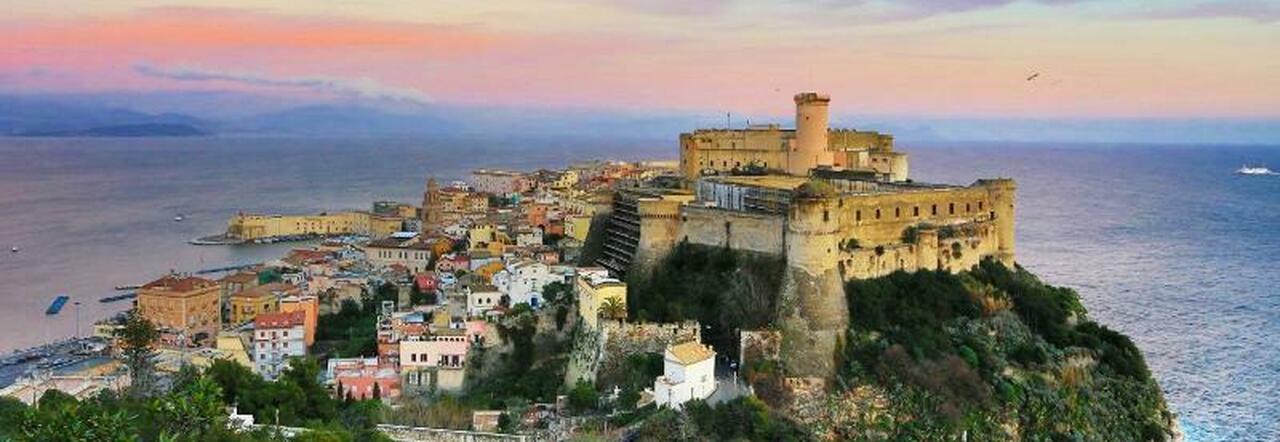It's called «The Blue and the Immensity of the Sea» and it's one of the strengths of the project with which the town of Lazio is running for Italian Capital of Culture 2026: «Our intention - explains the mayor, Cristian Leccese - is to be a tourist and cultural attraction of broad scope 365 days a year». A path curated by Cethegus, Giuseppe Daghino and Pierluigi Carofano.
Transforming Gaeta into a modern art and culture laboratory, allowing artistic initiatives to breathe uncontaminated in their evolutions. This is the aim of the Biennale The Blue and the Immensity of the Sea, one of the strengths of the project with which the town of Lazio is running for Italian Capital of Culture 2026: «Our intention - affirms the Mayor, Cristian Leccese, during the press conference presenting the event - is to make Gaeta a tourist and cultural reference point of broad scope, with an offer that is not limited to the summer months but that allows us to be a place of attraction for 365 days a year.
A three-year cultural journey, planned by Cethegus and curated by Giuseppe Daghino and Pierluigi Carofano, will begin in October of this year and end in April 2027: «We are convinced - explains Daghino - that ancient and contemporary art are together able to intercept Italian and international demand. With a universal language that brings together once distant worlds, generating a breaking down of cultural barriers that requires a new way of doing culture.
The Biennale therefore aims to build Gaeta's reputation as a place of excellence for cultural events and to improve its awareness and make it decidedly more attractive, as was recalled during the meeting marked by the extraordinary presence of the Gorgona Grezza, a sculpture by the great master Igor Mitoraj: «In this way - emphasizes Mayor Leccese - we want to increase tourist flows by promoting deseasonalization, generate wealth for the territorial economic system, guarantee strong media exposure to the city, propose a project functional to the development of teaching and, why not, favor a system architecture based on economies of scale.
More than 60 events are included in the bid for Capital of Culture 2026, and a first major exhibition from October 2024, «Metamorphosis», is included in this three-year cycle of exhibitions called «Medusa», whose symbolism embraces marine and mythological elements, given the strong connection between the sea and the culture of this territory.
«Medusa, one of the three Gorgons, is today - recalls Carofano - a true pop icon, full of charm that has not lost its luster over the centuries. Her seductive beauty of the gaze, associated with the terrible petrifying power, make her a timeless figure, capable of inspiring authentic masterpieces like those of Cellini, Caravaggio and Rubens, but also great artists of the twentieth century like Giulio Aristide Sartorio up to Igor Mitoraj. The exhibition intends to retrace through significant examples, the figurative fortune of this myth highlighting its polymorphic actuality, symbolic image derived from a mythical narration based on collective memory».
In the same way, the exhibition dedicated to Metamorphosis takes its cue from the homonymous text by Ovid, which enjoyed great fortune from the outset: «The myths of the gods and their transformations, the celebration of Trojan heroes up to their arrival in Lazio with Aeneas, the triumph of Julius Caesar and the prophecy of greater glory for Augustus, with which the poem ends, made this book - concludes Carofano - a kind of accessible sum not only of the history of humanity in its relationship with the divine, but also of Rome itself and therefore of the Latin world at its peak. The course of the exhibition will have a modular character, organized in chronological and thematic order: protagonists (demigods, heroes, high-ranking characters but also humble people) who undergo changes (nova corpora) into animals (such as, for example, Callisto in Orsa; Anio's daughters in doves), trees or flowers (Ciparisso and Narciso) or minerals (Niobe), but also water sources (Aretusa, Ciane, Egeria) or even in echo. Another journey will be that of protagonists who change sex (Ifide, Ceneo, Ermafrodito) or who from a lower state pass to a higher state (Deucalione and Pirra, Pigmalione, Enea's vessels in marine nymphs)».

